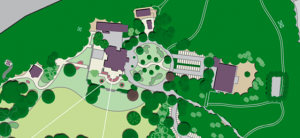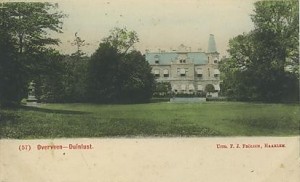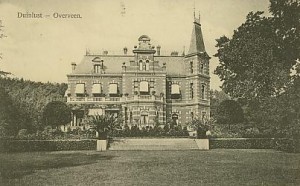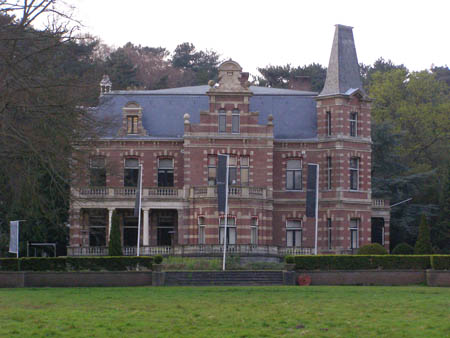In the previous post I expressed my dismay about the abolishment of visually important elements in a Spanish park, after it was restored or renovated. But Spain is of course not alone in this. We have our own examples in Holland.
A few years ago, for instance, things looked good for Duinlust, near Haarlem. A restoration plan was presented and there were even plans to execute it. I wrote about it in this post. Since then the economic crisis happened, a new owner arrived, one of the instigators of the plan (Stichting PHB) was liquidated – and the plan seems to have been dropped. The result is that I only have one tiny image of the original plan to show.
 One of the key components of the plan was to partly replant the hedges that had screened off the retaining walls of the terrace around the house. A local weblog shows a detail of the plan, where the hedges are vaguely visible along the edge of the terrace below the house. Although that blog post is just over a year old and the previous owner was still in place, the emphasis is on the restauration of two garden buildings, not on the hedges.
One of the key components of the plan was to partly replant the hedges that had screened off the retaining walls of the terrace around the house. A local weblog shows a detail of the plan, where the hedges are vaguely visible along the edge of the terrace below the house. Although that blog post is just over a year old and the previous owner was still in place, the emphasis is on the restauration of two garden buildings, not on the hedges.

 The postcards to the right show the situation before 1910. On both sides of the grand stairs leading up to the terrace (or down into the garden), hedges block the view at the retaining walls. This was not only the view from the garden but also from the sunken public road running past the house (Duinlustweg -it still is the view). The walls are not completely blocked, but enough to soften the blow of the eye hitting an ugly wall.
The postcards to the right show the situation before 1910. On both sides of the grand stairs leading up to the terrace (or down into the garden), hedges block the view at the retaining walls. This was not only the view from the garden but also from the sunken public road running past the house (Duinlustweg -it still is the view). The walls are not completely blocked, but enough to soften the blow of the eye hitting an ugly wall.
That wall is visible on my photo below, taken in 2007. The stairs need to be exposed, they are therefore covered with a layer of -now deteriorated- cement. The parts of the wall that should be covered by hedges simply consist of unembellished bricks. The photo also shows that hedges are now planted on the elevated terrace, effectively blocking the view from outside at the plants on display in the terrace garden.
 I don’t know when the current situation was created, but it obviously misses the elegance of the original layout. The idea of blocking the view at the wall was clearly better than the current situation. The retaining wall is similar to electricity units or other utility buildings in gardens: they are necessary, but one doesn’t want to see them. Plants are used to cover things up. In Dutch a term for that kind of planting is ‘schaamgroen’, a degrading term which practically reflects the reason of its existence and also the poor quality of the way these areas are generally fitted into larger historical layouts. But the tiny postcards above show that it doesn’t have to be that way.
I don’t know when the current situation was created, but it obviously misses the elegance of the original layout. The idea of blocking the view at the wall was clearly better than the current situation. The retaining wall is similar to electricity units or other utility buildings in gardens: they are necessary, but one doesn’t want to see them. Plants are used to cover things up. In Dutch a term for that kind of planting is ‘schaamgroen’, a degrading term which practically reflects the reason of its existence and also the poor quality of the way these areas are generally fitted into larger historical layouts. But the tiny postcards above show that it doesn’t have to be that way.
So I hope the new owners of Duinlust will pick up the restoration plans somewhere and get themselves some quality schaamgroen real soon.


